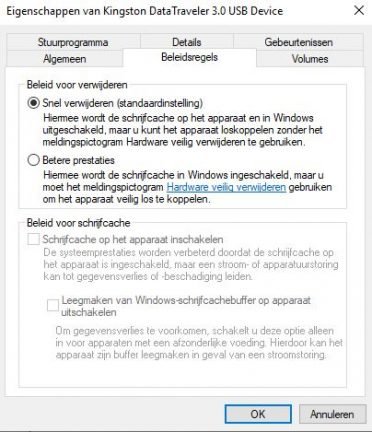The latest version of Windows allows you to remove a USB stick or Thunderbolt disk from your device without safely removing it first. The possibility also has some disadvantages.
Anyone using Windows is familiar with the need to safely remove external disks or USB sticks through the software before you are allowed to disconnect them from your laptop or desktop. This procedure has been redundant since version 1809 of Windows 10. Microsoft adjusted some default settings for this purpose, although there are also drawbacks associated with that decision.
Traditionally, Windows 10 (and all previous versions) used a setting that increases the performance of peripherals by using a cache setting when copying files. This cache ensures that files are copied more quickly, although in practice the cache still has to be emptied in the background towards the peripherals. If you removed a stick from the PC without first removing it safely, there was a danger that a cache operation was still in progress and that files would not be transferred correctly to the external media. Safe removal ensured that copying operations were definitely completed.
Choose
Microsoft now selects Quick Delete as its default setting. The cache is removed: when files are visibly finished copying, you can remove a stick from the PC without hesitation. This provides more flexibility, and less chance of corrupted files if you, like all Windows users, once forgot to use secure removal, but has the logical downside that the performance boost that the use of cache brings is undone.

If you are troubled by this, you can change the default mode for external storage back from quick delete mode to better performance mode. To do so, go to disk management (Win + R > diskmgmt.msc) and right-click on the external storage. Select properties and then policies to choose between the two options. Please note: if you choose Better performance again, then safe removal remains a must.
Related: Windows 10 May 2019 Update gives users re-control over updates
This news article was automatically translated from Dutch to give Techzine.eu a head start. All news articles after September 1, 2019 are written in native English and NOT translated. All our background stories are written in native English as well. For more information read our launch article.